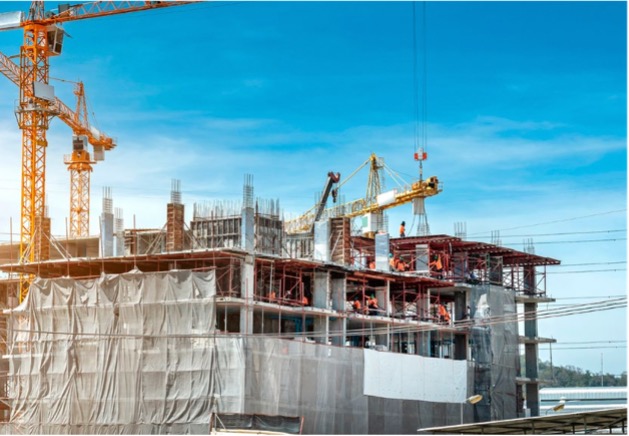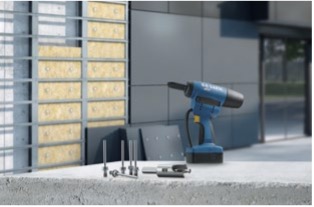Counting carbon to secure a more sustainable future

|
|
Words by Andrew Stolworthy, Director of Product and Market Development, SFS Group Fastening Technology Ltd. First appeared in issue 140 of the AT Journal, Winter 2021. |
Contents[hide] |
[edit] Counting carbon to secure a more sustainable future.
Sustainability has never been higher on the social and political agenda, but for designers and specifiers, there is an even greater challenge. The buildings now being planned or developed will stand for generations, meaning that the choice of what products to use is critical to the future of the built environment.
This is particularly acute when it comes to the amount of embodied (sometimes called embedded) carbon in building products. This is one of the key battlegrounds in the debate around sustainability and climate action – and something that needs to be clearly understood.
[edit] Understanding embodied carbon
Embodied carbon refers to all the carbon produced during the product’s life – which is not always easy to determine. A lot of the carbon you cannot see is locked in products, buildings, and infrastructure. The embodied carbon of these items come from more than just the materials used to build them.
When calculating embodied carbon in the industry, it is important to consider the carbon footprint of manufacturing processes as well as the materials used to create the product. Carbon emissions from the production of raw materials are part of the equation, as are those from shipping and transportation. In some cases, even assembling the parts into a finished product contributes to that product’s carbon footprint.
Understandably, embodied carbon in the built environment represents a significant portion of greenhouse gas (GHG) emissions and is a key challenge for the built environment sector. GHG emissions from the built environment can be divided into two categories: operational carbon – attributed to operational energy consumption during the building’s lifetime – and embodied carbon. Approximately 40% of energy related GHG emissions are driven by generating buildings, while 11% is generated from manufacturing materials, according to the Carbon Leadership Forum.
[edit] Identifying embodied carbon
For designers, specifiers and contractors, it makes sense to prioritise products with lower carbon footprints – and we are seeing more and more evidence that clients are asking for detailed information on this. Likewise, political and legislative pressure will increase – from framework agreements requiring proof of sustainability, to any new initiatives likely to emerge from the 2021 United Nations Climate Change Conference, also known as COP26.
The key question is: how can the carbon footprints products be effectively defined to include accurate information on embodied carbon?
Construction products environmental product declarations (EPDs) have become a growing source of environmental data. These are increasingly being used both in assessing buildings’ environmental performance and in comparing products for procurement decisions later on in the construction process. However, identifying and purchasing low-embodied carbon products can be challenging because of a lack of data quality and the lack of transparency of EPDs.
Currently, the UK has no formal regulation regarding embodied carbon emissions, despite construction of new buildings and infrastructure accounting for more than 10% of the national total of emissions. The campaign group ACAN (Architects Climate Action Network) is demanding the introduction of regulatory legislation in line with countries such as France, Finland and the Netherlands.
Likewise, Part Z – a lobby group comprising designers, structural engineers and sustainability experts – is seeking a new section to be added to the building regulations requiring compulsory whole-life carbon assessments.
[edit] Getting verified
Such game-changing action will take time. Until then, it is vitally important that designers and specifiers can at least understand the carbon footprint of the products they choose. That is why manufacturers must start, if they have not already, attaining verified environmental product declarations (EPDs) and confirming that their products comply with European Standard EN 15804.
This Standard, already a common requirement for many buildings at specification stage, describes the technical performance of the product through its life cycle, from raw materials through to manufacturing, construction, usage, maintenance, refurbishment and ultimately disposal.
Having a verified Environmental Product Declaration (EPD) means that designers and specifiers can trust the provenance of a product – notably what is in it, and how it has been made – to quantify the amount of embodied carbon within it.
The advantage of the verified mark for designers and specifiers is that it provides independent proof of the product’s sustainability, supporting compliance with Part L of the building regulations. For the manufacturer, there is the clear benefit of the product being recognised as fit-for-purpose from a sustainability perspective, thereby helping them to meet customer demands and specifications.
Yet there are additional advantages to complying with European Standard EN 15804. Knowing how much embodied carbon is used by a product provides a benchmark for future improvement, to support innovative, more sustainable product development. Likewise, the data serves as a guide towards potential cost reductions in energy, transport or manufacturing processes, as the manufacturer spots opportunities to reduce embodied carbon.
[edit] Making a difference
It is for all of these reasons that SFS has signed up to the BRE’s EPD scheme – as well as being part of the UN Global Compact and support the principle of introducing Approved Documents to cap embodied carbon emissions on all major construction projects.
We are now implementing the BRE’s online measuring tool, LINA, which gives us access to best-in-class EPD methodology. This ensures there is a hard scientific basis behind the calculations of embodied carbon, bringing transparency back into the supply chain as well as driving product innovation making more sustainable choices. We are currently in the process of getting our NVELOPE® subframe systems verified and will then roll out to other SFS products.
EPDs are but one of several measures we’ve adopted to help our customers make more informed choices about sustainability.
For example, The NVELOPE® Project Builder service for rainscreen subframes systems is an online tool available to building designers and specifiers that calculates all necessary considerations in a project’s initial planning stage. This not only allows for automated calculations of general building areas but also provides all component guides and list prices, NBS specifications and 3D modelling of thermal point loss areas.
Partnering Project Builder is our thermal lite tool. This calculates U-values, identifies sources of thermal bridging, and offers specific, tailored guidance on reducing thermal performance gaps due to cold bridging – in turn, making a positive impact on building sustainability.
These tools are all available through SFS’ ConnectSuite®, an online portal that hosts smart tools and apps like product selectors and visualisers to streamline specification and design processes – making the transition to digital integration as seamless as possible.
[edit] Securing futures
Regardless of legislative change, the benefits of knowing how much embodied carbon there is in building products should be obvious. Designers and specifiers want only the best for their buildings – and any definition of best must include sustainability in its criteria.
Whether by helping those designers and specifiers to make more informed choices today, or by challenging ourselves to think differently about how we source, manufacture and transport products, we are excited by the possibilities. We are invested in knowing where our products go and how they interact throughout the whole lifecycle of the building – and, consequently, to see how we can make positive changes, even small ones, that will impact on the built environment.
Measuring embodied carbon is just the start, and we are already on the pathway to other digital technologies such as BIM digital twin capabilities. There is still much to be done though, which is why we are actively engaging with industry partners and bodies such as Construction Excellence. Plus, we have joined initiatives such as the Construction Innovation Hub Platform Project, which is working to identify, refine and develop solutions that can be deployed at scale, across multiple projects and sectors, to realise greater efficiencies and making positive change in terms of sustainable construction.
At SFS, we believe in securing futures, and this scheme helps us in that goal. After all, today’s building plans are tomorrow’s homes, offices, shops, hotels and hospitals. To secure those futures, the work starts right now.
--CIAT
[edit] Related articles on Designing Buildings
- BPIE report urges EU to incorporate the carbon footprint of construction into policy.
- Carbon footprint.
- Climate change science.
- Climate Emergency Design Guide.
- Cradle to grave.
- Embedded carbon emissions.
- Embodied carbon.
- Embodied energy.
- Industry proposes building regulations part Z.
- PHribbon tool calculates embodied carbon of designs.
- Upfront emissions.
- Use stage embodied carbon.
Featured articles and news
BSRIA Statutory Compliance Inspection Checklist
BG80/2025 now significantly updated to include requirements related to important changes in legislation.
Shortlist for the 2025 Roofscape Design Awards
Talent and innovation showcase announcement from the trussed rafter industry.
OpenUSD possibilities: Look before you leap
Being ready for the OpenUSD solutions set to transform architecture and design.
Global Asbestos Awareness Week 2025
Highlighting the continuing threat to trades persons.
Retrofit of Buildings, a CIOB Technical Publication
Now available in Arabic and Chinese aswell as English.
The context, schemes, standards, roles and relevance of the Building Safety Act.
Retrofit 25 – What's Stopping Us?
Exhibition Opens at The Building Centre.
Types of work to existing buildings
A simple circular economy wiki breakdown with further links.
A threat to the creativity that makes London special.
How can digital twins boost profitability within construction?
The smart construction dashboard, as-built data and site changes forming an accurate digital twin.
Unlocking surplus public defence land and more to speed up the delivery of housing.
The Planning and Infrastructure Bill
An outline of the bill with a mix of reactions on potential impacts from IHBC, CIEEM, CIC, ACE and EIC.
Farnborough College Unveils its Half-house for Sustainable Construction Training.
Spring Statement 2025 with reactions from industry
Confirming previously announced funding, and welfare changes amid adjusted growth forecast.
Scottish Government responds to Grenfell report
As fund for unsafe cladding assessments is launched.
CLC and BSR process map for HRB approvals
One of the initial outputs of their weekly BSR meetings.
Building Safety Levy technical consultation response
Details of the planned levy now due in 2026.
Great British Energy install solar on school and NHS sites
200 schools and 200 NHS sites to get solar systems, as first project of the newly formed government initiative.
600 million for 60,000 more skilled construction workers
Announced by Treasury ahead of the Spring Statement.





























